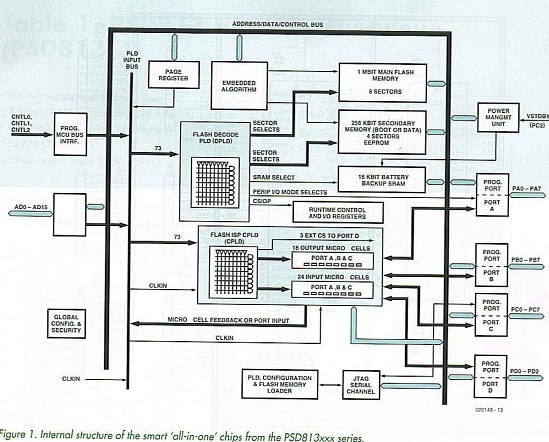

Project Solutions
Drop-in Microcontroller Board (1)
Published:2011/7/27 21:29:00 Author:Phyllis From:SeekIC
An 80C32 jack-of-all-trades
At the heart of this remarkably compact microcontroller board you’ll find an ingenious bit of integration technology. The combination acts as a versatile plug-in module for lots of applications requiring some form of intelligent control. Thanks to the extensive software that comes with the board and the presence of a PC interface, our drop-in board is excellent for hardware development, too.
As many of our readers will be able to confirm, the majority of microcontroller boards look very similar. If the microcontroller used has no program memory, an EPROM is added. Similarly, if there is a lack of RAM, the problem is solved by adding an external RAM device like the 62256. The lot is then complemented with a few logic gates and hey presto we have a basic microcontroller system. In some cases the designer will go one step further by employing a little more than just the microcontroller I/O pins. Some more digital electronics is then in order, but that really wraps it up as far as the circuit is concerned.
PSD813 series
Okay, if all these microcontroller circuits are so similar, why not design a single integrated circuit that contains all functionality? That way, circuits can become much smaller and the designer could concentrate on those points that are unique to the circuit. This, we figure, must have gone through the heads of several designers at STMicroelectronics (formerly SGS Thomson), the general idea having culminated in a series of ICs called ’PSD813xxx’. The individual components inside the chip are found back in Table 1. Obviously, this IC offers far more possibilities for a wide variety of microcontroller circuits. 
Figure 1 shows a block diagram illustrating the internal structure of the PSD813xxx chips. 
The memories may be mapped on a segment by segment basis. This creates many different configurations, for example, first 16 K Flash, followed by two 8 K EEPROM segments and then another 32 K of Flash memory.
The memory management is also very handy. For example, using the page registers allows you to increase the controller’s address range. Another possibility is to configure the memory in a different way depending on the page register contents. The samples show how this is done in practice.
The CPLD section in principle obviates the logic that’s normally required to drive peripheral devices, but only if the designer is satisfied with 27 I/O pins. For a controller with a multiplexed bus, this allows a de-multiplexed address to be created by the chip and, if necessary, a tri-state databus. Other applications include generating chip select signals for the peripheral devices or even creating extra I/O ports.
The PSD813 series has not been designed for one specific family of microcontrollers. In fact, it is so versatile that it can be used with several microcontroller families. These include not only micros with a standard address bus and databus, but also types with a multiplexed data/address bus like the 80C32, 8051XA and the 68HC11.
One final point to mention in this short profile is the JTAG port that allows all functions of the chip to be programmed in-circuit. In other words, it is not necessary to buy an expensive programmer — and that’s good news.
Reprinted Url Of This Article: http://www.seekic.com/blog/project_solutions/2011/07/27/Drop_in_Microcontroller_Board__(1).html
Print this Page | Comments | Reading(703)
Article Categories
New published articles
· Imagination works with TSMC to develop FinFET process
Author:Ecco Reading(32821)
· XMOS pushes event-driven MCUs with lower price
Author:Ecco Reading(3526)
· Intel brings upgraded 32-nm SoC for smartphones
Author:Ecco Reading(3246)
· Micron pushes TLC 128-Gbit NAND flash
Author:Ecco Reading(3801)
· Intel will stop supplying desktop motherboards
Author:Ecco Reading(5331)
· Processor market was expected to regain strength in 2013
Author:Ecco Reading(3315)
· It was reported that TSMC sales fall steeply
Author:Ecco Reading(3462)
· Cisco, NXP work with auto wireless startup
Author:Ecco Reading(3604)
· Micron was impacted by manufacturing glitch
Author:Ecco Reading(4009)
· China can make 22-nm transistor by themselves
Author:Ecco Reading(3807)
· Chip market rebound is coming, according to survey
Author:Ecco Reading(3748)
· Sony, Toshiba will spend more on chips, iSuppli reports
Author:Ecco Reading(3780)
· Qualcomm becomes the 13th company to join NFC Forum board
Author:Ecco Reading(6094)
· TSMC increases building work for FinFET fab
Author:Ecco Reading(3764)
· TI plans to cut 1,700 jobs in OMAP shift
Author:Ecco Reading(4579)